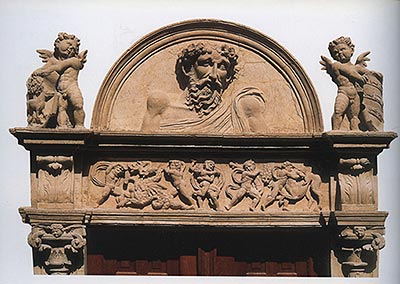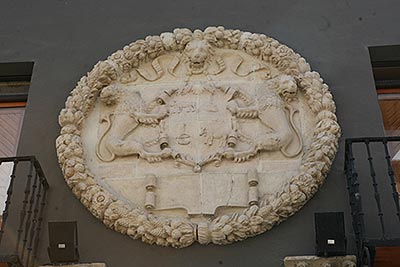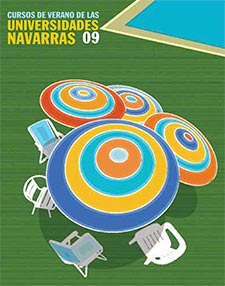BRINGING THE HERITAGE CLOSER. ESTELLA, ART AND THE ROAD
27 August 2009
Architecture and Humanism in Estella in the 16th century
Ms. María Josefa Tarifa Castilla. Chair of Navarrese Heritage and Art
Estella, a remarkable town on the Pilgrim's Way to Santiago de Compostela with an important medieval imprint and important monuments, became a modern city with the arrival of the 16th century, an important centre for humanism and the arts in the 16th century. The beginning of a period of peace after the annexation of Navarre to Castile in 1512 and the consequent economic and commercial revival of the city with two markets, led to a cultural flourishing, whose intellectual support came from the Grammar School sponsored by the municipality itself, with the presence of notable masters such as graduate Juan de Cemboráin and the Portuguese Francisco de Barbosa. The installation of the printing press in 1546, the third in Navarre, by Miguel de Eguía, a member of the distinguished family of the same name from Estella, who learned the art of printing from Arnaldo Guillén de Brocar, also contributed to this.
This cultural reactivation was also reflected in the arts, in the case of the architectural field, on the one hand, with small interventions in the medieval urban fabric with the aim of beautifying the city and making it more functional, which resulted in the remodelling of the city gates, of which the portal de Castilla is an example, the arrangement of squares, especially San Martín, the paving of the main streets to make them more accessible, the bringing of water and the construction of fountains, such as the Chorros or La Mona, one of the few Renaissance fountains that have been preserved. In the case of religious architecture, the high issue of medieval parishes, churches, convents and monasteries was sufficient to meet the spiritual needs of the growing parishioners, which is why no new churches were built, and small interventions were carried out on existing buildings in need of refurbishment, but agreement to the new Renaissance language, as exemplified by the star-shaped vaults that cover the central nave of the parish church of San Miguel, undertaken in 1537 by the stonemason Juan de Aguirre.
On the other hand, it was civil architecture that was to shine in all its splendour, thanks to Building by the noble and wealthy merchants of palaces and manor houses that are among the most exceptional of those erected in this century throughout Navarre, sometimes with a humanistic programme sculpted on their façades alluding to the values of good citizenship and the virtues displayed by the owner of the house, such as the palace of the San Cristóbal or house of Fray Diego de Estella, promoted by Diego de San Cristóbal Ballesteros y Eguía, whose work was supervised by the stonemason Martín de Oyarzábal, or the palace of the Eguía family, commissioned by one of the great men of Estella in the first third of the 16th century, Juan de Eguía, who also founded the General Hospital of that town.

Estella. Palace of the San Cristóbal family. 16th century. Detail of the balcony with the representation of the labours of Hercules.

Estella. Palace of the Eguía family. 16th century. Detail of the coat of arms
PROGRAM
TUESDAY, AUGUST 25
The splendor of Estella in the Renaissance. Art and Artists
Ms. María Concepción García Gainza. Chair of Navarrese Heritage and Art.
Image of God, image of man: the façade of San Miguel de Estella
Mr. Javier Martínez de Aguirre Aldaz. Complutense University of Madrid
San Pedro de la Rúa: styles and interstyles in a medieval building.
D. Carlos J. Martínez Álava. I.E.S. "Pedro de Ursua" of Pamplona
WEDNESDAY, AUGUST 26TH
Following in the footsteps of the Gothic in Estella: Santo Sepulcro and Santo Domingo
Ms. Santiaga Hidalgo Sánchez. Chair of Navarrese Heritage and Art.
Estella's movable heritage
Ms. Mercedes Jover Hernando. Chair of Navarrese Heritage and Art.
A city born for the Camino. visit guided tour of the city of Estella
D. Román Felones Morrás. Full Professor of Geography and History of the I.E.S. Tierra Estella.
THURSDAY, AUGUST 27TH
Architecture and Humanism in Estella in the 16th century.
Mrs. María Josefa Tarifa Castilla. Chair of Navarrese Heritage and Art.
Traces of the Baroque in Estella
Ms. Pilar Andueza Unanua. Chair of Navarrese Art and Heritage.
The sumptuary arts in Estella: from the Age average to the 19th century.
D. Ignacio Miguéliz Valcarlos. Chair of Navarrese Heritage and Art.
FRIDAY, AUGUST 28TH
Images of a conflict. Estella and the last Carlist War
D. Ignacio Jesús Urricelqui Pacho. Chair of Navarrese Heritage and Art.
reportIdentity and image of Estella in the plastic arts of the 19th and 20th centuries.
Mr. José Javier Azanza López. Chair of Navarrese Heritage and Art.
Museum and city. Gustavo de Maeztu and Estella
D. Gregorio Díaz Ereño. Director of the Jorge Oteiza Museum.
Closing

